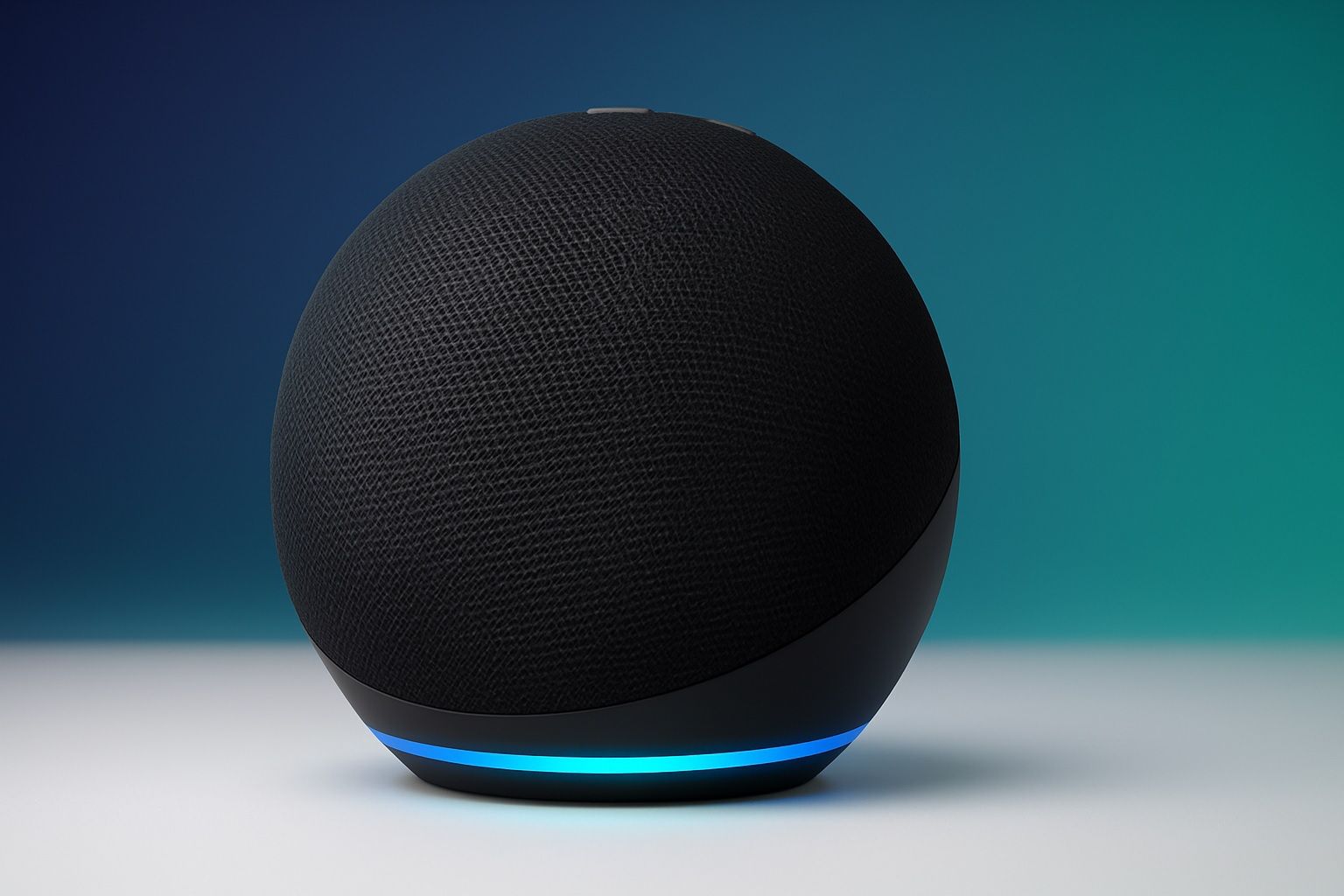- Amazon’s Alexa+ entered broad early access by mid-2025 and surpassed 1 million users by June 2025.
- Alexa+ is free for Amazon Prime members and costs $19.99/month for others, and it orchestrates “experts” across services like OpenTable, Spotify, and Uber Eats.
- Alexa+ can remember personal details and even has its own email for user-provided information, enabling more complex multi-step requests than the old Alexa.
- In Early Access, about 90% of Alexa+ features are live, with hands-free shopping and advanced video controls still under development.
- Apple’s Siri saw no major generative AI launch in June 2025, with delays to a likely iOS 19 release in fall 2025, and reports that Apple is weighing OpenAI or Anthropic models for a next-gen Siri.
- Google rolled out free-form voice conversations in AI Search Mode in June 2025 and previewed a Bard-powered “Assistant” revamp, with Gemini 2.5 generally available and a Flash Lite on-device model.
- OpenAI’s ChatGPT added Advanced Voice Mode on June 7–8, 2025, delivering more natural intonation, emotion, and real-time translation in mobile apps for paying subscribers.
- Microsoft began testing a “Hey, Copilot” hotword for Windows 11 in late June 2025, with local wake-word processing, a Win+C push-to-talk shortcut, and Copilot Vision plus voice-enabled mobile Copilot Chat.
- Meta launched the Meta AI app in late April 2025, updated by June 26, 2025, as a standalone voice assistant based on Llama 4 that can web-search, integrate with Messenger, and connect to Ray-Ban Stories.
- EU regulators designated Apple as a gatekeeper under the DMA, forcing iPhone/iPad/Mac to support switching to a third-party default voice assistant and prompting broader interoperability and privacy considerations.
Major Product Launches and Updates
Amazon Alexa+ Rollout and Features: Amazon’s generative AI upgrade for Alexa – dubbed Alexa+ – entered broad early access by mid-2025. After a February launch event, Alexa+ was initially available to a limited group and reached over 1 million users by June [1]. Alexa+ is a next-gen voice assistant that is free for Amazon Prime members (and will cost $19.99/month otherwise) [2]. It brings much more conversational abilities and can perform complex tasks by orchestrating “experts” (API-based skills) across services like OpenTable, Spotify, Uber Eats, and more [3] [4]. Early users report Alexa+ can remember personal details (even has its own email for user-provided info) and handle multi-step requests far better than the old Alexa [5] [6]. However, Amazon is rolling out Alexa+ cautiously – only ~90% of promised features are live in the Early Access program, with some capabilities (like hands-free shopping or advanced video controls) still under development [7] [8]. Amazon’s Devices chief Panos Panay has insisted on ironing out problems before a full release, given Alexa’s role in “millions of people’s daily lives” [9]. Notably, at Apple’s June WWDC, a smarter Siri was a no-show, underscoring how Alexa’s evolution has leapfrogged Apple’s assistant [10].
Apple Siri’s Incremental Progress and Delays: Apple’s voice assistant Siri saw no major generative AI launch during this period – instead, Apple acknowledged delays in its planned upgrades. At WWDC 2024 (a year prior), Apple had announced forthcoming Siri improvements like on-screen situational awareness, personal context memory, and multi-app actions powered by large language models [11]. These were expected by iOS 18.4 in spring 2025 but did not arrive; Apple’s June 2025 update was that Siri’s enhanced version “needs more time” and will likely ship with iOS 19 in fall 2025 [12] [13]. In Apple’s words, “It’s just taking a bit longer than we thought” [14]. Meanwhile, Apple is reportedly considering a major strategy shift – using third-party AI models from OpenAI or Anthropic to power Siri’s next-gen version [15] [16]. Apple has held early talks with those AI providers about training LLMs on Apple’s secure cloud, though no decision is final [17]. This would be a “major reversal” for Apple, which historically kept Siri’s tech in-house [18]. The backdrop to these moves is Apple’s internal reorganization of its AI teams: after Tim Cook lost confidence in Siri’s slow progress, Apple put a new executive (Mike Rockwell) in charge and promised investors a more capable Siri by 2026 [19] [20]. During this period, Apple’s main Siri-related highlights were incremental: e.g. an iOS 18 feature for live voice translation of phone calls was showcased at WWDC 2025 [21]. Also, in response to EU regulations, Apple confirmed it will let European users change the default assistant away from Siri – a significant policy change (see Regulation below) [22]. Overall, commentators noted that Siri has fallen behind in the “AI boom” and is still perceived as less capable than rivals like Alexa or Google Assistant [23].
Google Assistant and Bard Integration: Google is moving to infuse its voice assistant with generative AI from its Bard/Gemini models. While Google didn’t launch a brand-new assistant app in June–July, it rolled out notable features linking voice input and AI. In June, Google enabled free-form voice conversations with its AI Search Mode on mobile: users can now talk back-and-forth with Google’s search AI using voice, getting spoken answers and follow-ups in real time [24] [25]. This essentially brings Google’s conversational Search Generative Experience into a hands-free mode, allowing multitasking and saving transcripts for later [26] [27]. Google is also previewing “Assistant with Bard” – an upcoming revamp that combines Google Assistant’s device-control skills with Bard’s conversational prowess. Leaked screenshots and reports indicate a new Assistant toggle in the Google app that launches a Bard-powered helper with options to type, talk, or even input images [28] [29]. This next-gen Assistant (expected later in 2025) is pitched as a “more capable and adaptable AI helper” on your phone, handling both standard queries (timers, messages) and open-ended questions [30] [31]. It’s currently in testing, but Google’s AI blog hints that voice will play a central role – the company explicitly announced it’s “expanding ways to search with your voice and AI” across products [32] [33]. Google’s underlying AI models also advanced: in June it made its Gemini 2.5 LLM family generally available and even released a Gemini 2.5 Flash Lite model for faster, on-device uses [34]. These upgrades will likely feed into Google’s assistant. In short, Google is laying the groundwork for a voice-enabled Bard assistant, aiming to catch up to the more AI-centric experiences offered by Alexa+ and ChatGPT.
OpenAI ChatGPT’s Voice Upgrade: OpenAI’s ChatGPT (while primarily a text chatbot) took a significant step into voice interaction in June 2025. The company rolled out an Advanced Voice Mode update for ChatGPT’s mobile apps, making the AI’s speech output far more natural and expressive [35] [36]. For paying subscribers, ChatGPT’s voice now features subtler intonation, human-like cadence, and even emotional inflections (it can sound enthusiastic, sarcastic, empathetic, etc.) [37] [38]. This update, released June 7–8, 2025, is widely seen as giving ChatGPT a more lifelike persona that “feels as natural as chatting with a friend” [39] [40]. Real-time translation is another new ability – users can have ChatGPT serve as a live interpreter in a conversation, continuously translating back-and-forth in multiple languages [41] [42]. For example, you can speak English and have ChatGPT immediately respond in Portuguese, then translate a Portuguese speaker’s reply back to English, all in one seamless voice session [43]. This mirrors a similar live translation feature Apple announced at WWDC, and indeed OpenAI’s timing was likely no coincidence [44]. ChatGPT’s voice mode can now also be invoked through smartphone assistants – on iOS, users can launch ChatGPT via Siri shortcuts, essentially integrating ChatGPT’s brain behind Apple’s voice interface [45]. The improved voice capability makes ChatGPT a viable “voice assistant” competitor to Siri or Alexa in many scenarios. Tech commentators noted that ChatGPT’s new voice is so advanced it “gives Siri a run for her money” [46]. With this update, OpenAI continues to blur the lines between chatbots and voice assistants, pushing incumbents to up their game.
Microsoft Copilot: Ubiquitous Assistant with Voice and Vision: Microsoft has been aggressively integrating its AI Copilot across Windows, Office, and more – and recent updates emphasize voice interaction. In late June 2025, Microsoft began testing a “Hey, Copilot” hotword in Windows 11, allowing users to summon the built-in AI assistant with a hands-free voice command (much like “Hey Siri” or “Hey Google”) [47] [48]. This voice activation is opt-in and processes the wake word locally for privacy [49]. Once enabled, saying “Hey, Copilot” triggers a listening overlay (a mic icon appears) and you can ask the Windows Copilot to draft emails, summarize documents, adjust settings, etc., entirely by voice [50] [51]. Microsoft also added a push-to-talk voice shortcut: pressing Win+C (Windows key + C) and holding it for 2 seconds will initiate a voice query to Copilot anywhere in Windows [52]. These changes effectively transform Copilot into Microsoft’s new voice assistant on PCs, succeeding Cortana (which was retired). On the mobile side, Microsoft 365 Copilot’s app introduced natural voice chat input – iPhone users can now speak to Copilot Chat and get spoken responses, useful for on-the-go use or accessibility needs [53]. Additionally, Microsoft rolled out “Copilot Vision”, a feature where users can upload images for Copilot to analyze or describe (for instance, it can generate alt-text or understand a diagram) [54]. This multimodal upgrade, along with voice, shows Microsoft’s Copilot moving toward a fully conversational agent that works across modalities. In summary, by mid-2025 Microsoft’s Copilot was everywhere: in Office apps, in Windows 11, and reachable via voice commands, embodying CEO Satya Nadella’s vision of an “AI companion” integrated into all major Microsoft products. Early user feedback has been positive – Microsoft notes that AI assistance can save several minutes per task and reduce user fatigue, especially for routine documentation in enterprise settings [55] [56].
Meta’s Personal AI Assistant App: Meta (Facebook’s parent) made a significant entrance into the consumer assistant arena by launching the Meta AI app. Announced in late April and updated through June 26, 2025, the Meta AI app is a standalone voice assistant powered by Meta’s new Llama 4 large language model [57] [58]. The app is positioned as a “personal AI” that remembers your preferences and context to give tailored responses [59] [60]. For example, Meta AI can integrate with your Facebook/Instagram data (if you allow it) – like your interests, friend list, or past posts – to personalize answers and recommendations [61]. The app supports voice conversations out of the box: users can press a button and talk naturally to Meta AI, which responds with a voice. Meta even built a full-duplex voice demo (allowing interruptible, real-time conversation) to showcase a more human-like dialogue flow [62]. (This demo mode uses an on-device model and doesn’t access the internet, as Meta is still perfecting the tech [63].) The Meta AI app can also perform image generation and editing via voice commands, merging multimodal capabilities into the conversation [64]. At launch, Meta AI’s knowledge is web-connected – it can do web searches for up-to-date info – and it ties into Meta’s ecosystem (for instance, it can use Messenger to send a message or help you post something) [65]. Notably, Meta is also making this the companion app for its smart glasses (Ray-Ban Stories): the idea is you could ask your AR glasses a question and Meta AI (through the app) would answer in your ear [66] [67]. The app debuted in the U.S., Canada, UK, and a few other English-speaking markets, with Meta gathering feedback for global expansion [68]. Meta’s rollout underscores the company’s ambition to have a cross-platform assistant spanning social media, messaging, and even AR – leveraging its social data troves as a differentiator. In the same vein, Meta open-sourced new versions of its Llama models this summer (Llama 3 in early 2025, followed by Llama 4 in mid-2025), aiming to nurture an ecosystem of AI developers and perhaps find its assistant embedded in third-party apps as well [69] [70].
Strategic Moves, Investments, and Partnerships
Meta’s AI Investments and Acquisitions: Meta made headlines with several bold moves to bolster its conversational AI capabilities. In late June 2025, news broke that Meta is in advanced talks to acquire PlayAI, a voice-AI startup known for its cutting-edge text-to-speech and voice agent platform [71] [72]. PlayAI had developed voice cloning tech and multi-turn dialogue models, and Meta’s interest suggests it wants to infuse more natural voice tech into its assistant and devices (like smart glasses) [73] [74]. The deal would reportedly include bringing PlayAI’s key employees into Meta [75]. Around the same time, it was revealed that Mark Zuckerberg approached numerous AI startups for potential deals; while many turned him down, Meta did succeed in taking a 49% stake in Scale AI (an AI data platform) for $14.3B and even poached Scale’s CEO to lead Meta’s “superintelligence” efforts [76] [77]. Meta also hired several former OpenAI researchers [78]. These aggressive moves come as Zuckerberg is reportedly frustrated with the pace of Meta’s internal AI (Llama) development and is “beefing up” the team with outside talent and tech [79]. In the big picture, Meta is spending heavily (over $500M allocated this year) to ensure it can compete in voice and conversational AI – including navigating challenges from upcoming EU AI regulations that could constrain data usage [80] [81].
Cross-Industry Partnerships: The period saw a variety of alliances aimed at integrating conversational AI into products and services:
- Automotive: Automakers continued partnering with AI firms to power in-car voice assistants. Stellantis, for example, deepened its tie-up with French startup Mistral AI to build an in-vehicle assistant with natural conversation capabilities across its brands (Peugeot, Jeep, Fiat, etc.) [82] [83]. This assistant will let drivers ask questions about car features or get troubleshooting help, functioning as an interactive user manual and more [84]. It’s part of Stellantis’ broader GenAI rollout across engineering and sales operations [85] [86]. Meanwhile, Volkswagen teamed up with voice-tech company Cerence to integrate ChatGPT-based dialogue into VW’s “IDA” assistant. That system, first piloted in late 2024, began a broader global rollout through 2025, enabling more open-ended, conversational Q&A with the car’s assistant (in multiple languages) rather than rigid voice commands [87] [88]. These partnerships illustrate how carmakers are racing to offer smarter voice assistants in vehicles – from answering general questions to controlling car functions with plain speech.
- Voice AI + Search: A notable collaboration was SoundHound AI partnering with Perplexity AI (a startup from former OpenAI and Meta folks) to combine SoundHound’s voice interface with Perplexity’s LLM-powered answer engine [89] [90]. Announced in May (just before our timeframe), this integration allows SoundHound’s voice assistant (which is used in some car infotainment systems and mobile apps) to provide up-to-date, conversational answers drawing on web knowledge, courtesy of Perplexity [91] [92]. In effect, SoundHound’s assistant gains a “brain upgrade” – for example, a driver could ask, “What are gas prices like this week compared to last?” and get a live answer with context, then follow up with “Navigate to the cheapest nearby gas station.” The system would handle the conversational Q&A and then execute the action via navigation software [93] [94]. By mid-2025, SoundHound’s generative voice assistant (boosted by such partnerships) has been deployed in new cars across at least 12 countries and 18 languages through its deal with Stellantis [95]. This shows how voice AI companies are partnering to cover each other’s gaps – marrying voice UX with generative intelligence.
- Enterprise and Call Centers: Established enterprise tech players also aligned to bring AI to customer service. For instance, NVIDIA struck a deal with Yum! Brands (parent of KFC, Taco Bell, Pizza Hut) to implement conversational AI in call centers for phone orders [96]. Using NVIDIA’s AI platforms, the idea is to let an intelligent voice agent take orders or field calls especially during peak hours, reducing wait times for customers [97]. Similarly, many banks, telcos, and retailers have been evaluating partnerships with conversational AI vendors to automate routine customer calls. (One example: Lloyds Banking Group in the UK partnered with a startup Unlikely AI to enhance its customer support automation with more understanding and nuance [98].)
- Virtual Assistant Platforms: The big tech companies continued strategic maneuvers too. Amazon is leaning on partnerships via its Alexa ecosystem – it invited developers to integrate their content and APIs as “Alexa Skills” and now as Alexa “experts” for Alexa+ [99]. Amazon’s generative Alexa+ essentially brokers across tens of thousands of partner services (from Spotify to OpenTable) to fulfill user requests in a more fluid way [100]. By not charging Prime users for Alexa+, Amazon is clearly aiming to drive engagement and stave off competition. Google, for its part, expanded its Cloud partnerships: in late June it announced a collaboration with education company Pearson to integrate Google’s AI tutor technologies (likely conversational) into classroom tools [101]. And Microsoft maintained its deep alliance with OpenAI (providing Azure cloud muscle for ChatGPT) while also launching a Copilot Partner Program for software firms to embed Microsoft’s copilots into their apps.
All these moves underscore an industry trend: conversational AI is viewed as a platform play, and companies are investing in talent, acquisitions, and partnerships to secure the best models and integrations. Venture capital is also pouring in (see Market Trends below), which has led to a flurry of startup alliances with bigger players.
Emerging Use Cases Across Industries
Voice and conversational AI are finding expanding applications in various sectors. During June–July 2025, several notable deployments illustrated this momentum:
- Healthcare: Hospitals and health systems began using AI “agents” to automate routine patient communication. For example, in June the major hospital operator Universal Health Services (UHS) announced it has deployed generative AI virtual nurses (from startup Hippocratic AI) to handle post-discharge follow-up calls to patients [102] [103]. These voice agents, nicknamed “Daisy”, call patients after they leave the hospital to check on symptoms, review medication instructions, and answer common questions [104] [105]. They can even alert human staff if a patient reports concerning symptoms, so a nurse can call back promptly [106]. UHS reported that thousands of patients have already been contacted by the AI, with an average satisfaction of 9 out of 10 [107]. Executives noted this helps catch complications early and frees up nurses’ time, all while maintaining a friendly bedside manner – many patients found “Daisy” comforting and helpful [108] [109]. Beyond follow-ups, conversational AI is being trialed for patient scheduling, triage and even as a documentation assistant for clinicians. In fact, Microsoft released Dragon Copilot (early 2025) as a clinical voice assistant that listens in on doctor-patient visits, transcribes notes, and can automate orders or referrals via voice commands [110] [111]. By mid-2025 it was being rolled out in U.S. hospitals, aiming to reduce doctors’ paperwork and burnout. Large healthcare providers like Allina Health also started using AI voice agents (“Alli”) to answer inbound patient calls – handling appointment bookings and prescription refill requests conversationally [112]. These examples indicate that medical use-cases for voice AI – from “digital nurses” to voice dictation for doctors – are quickly gaining acceptance.
- Automotive: The car is becoming a prime venue for voice assistants. We saw automakers integrate chatbot-like AI into cars to go beyond simple navigation or music commands. For instance, Mercedes-Benz last year piloted a ChatGPT-driven upgrade to its MBUX assistant (that pilot continued into 2025, with Mercedes reporting positive engagement) [113]. By early 2025, Volkswagen was deploying an AI assistant in models like the ID.7, via Cerence’s platform, that lets drivers hold a “conversational chit-chat” with the car – asking general knowledge questions or even having light banter [114] [115]. Peugeot (part of Stellantis) announced it will add a ChatGPT-based voice assistant to new vehicles as well [116]. These systems leverage cloud AI to answer things like “Where’s the nearest EV charging station with a café?” or “Remind me what the speed limit is here,” without the driver needing to take eyes off the road. They also handle vehicle controls: e.g. “I’m cold” could trigger the AI to increase temperature. By integrating robust NLP, automakers hope to make in-car assistants more natural and safer for drivers (reducing touchscreen fiddling). Automotive AI isn’t limited to infotainment – under the hood companies are using conversational agents for engineering and support. Stellantis not only works on the in-car voice assistant but also created an internal “Virtual Assistant” for employees in France to help with company car purchases, supporting voice queries in multiple languages [117]. This shows how even internal corporate helpdesks are leveraging conversational AI. The auto industry’s rapid adoption of voice tech is so striking that one executive said these AI assistants are “transforming vehicles into interactive companions.”
- Customer Service & Call Centers: Perhaps the fastest-growing use case is using conversational AI as customer support agents. In 2025, businesses are increasingly deploying AI-driven voice bots to handle calls that used to require human reps. A report from VC firm Andreessen Horowitz highlighted that voice AI agents are now often outperforming call centers and can handle many tasks at lower cost [118]. Common scenarios include after-hours calls (instead of sending customers to voicemail, an AI agent can answer basic inquiries or take a message/appointment) and overflow calls during peak times [119]. For instance, the fast-food conglomerate Yum! Brands (KFC/Pizza Hut) is rolling out AI agents to take phone orders when restaurants are busy [120]. Jersey Mike’s, a U.S. sandwich chain, has introduced SoundHound’s voice AI in 50 stores so that customers can place orders by talking to an kiosk or phone system, with the AI accurately capturing their sandwich customizations [121]. Early results show such systems can handle a majority of routine orders – and importantly, most customers don’t realize they’re talking to a bot. Indeed, eHealth’s chief digital officer noted that AI voices have gotten “so humanlike” that customers often cannot tell the difference anymore [122]. This reflects major advances in speech naturalness and dialog management over the past 12–18 months [123] [124]. Another example: Allina Health’s new AI agent (Alli) answers thousands of patient calls, managing tasks like appointment scheduling and FAQs about clinic hours, and will soon handle prescription refill requests – tasks that typically bogged down call centers [125]. By picking up calls 24/7 with zero hold time, these agents greatly improve response times and free human staff for more complex issues [126] [127]. Analysts predict voice AI will become the first point of contact for many service interactions. However, it’s not a panacea – quality control is crucial. A cautionary tale was McDonald’s: it piloted a drive-thru voice AI (with IBM) but had to pause the project after a few high-profile mistakes went viral, raising reputational concerns [128]. Companies are learning that while voice bots can be extremely effective, they must be carefully tested to avoid egregious errors in public-facing roles.
- Smart Home and IoT: The classic domain of voice assistants – smart speakers and home devices – is also evolving with new use cases. With Amazon Alexa+, smart home users can give much more complex commands now. For example, instead of issuing one command at a time (“lock the door” then “turn off the lights”), users can say “I’m headed out, can you secure the house and turn everything off?” and Alexa+ will intelligently perform a sequence (lock smart locks, arm security, turn off lights, adjust thermostat) in one go [129] [130]. Alexa+ can also proactively suggest smart home routines based on context it learns (e.g. reminding you to lock up if it’s late) [131] [132]. In the smart home space, another emerging use case is voice-controlled appliances with embedded assistants: several appliance makers have begun adding mini voice assistants (often Alexa or Google Assistant) directly into ovens, microwaves, and fridges so that users can set timers or get cooking help hands-free. During this period, manufacturers have been upgrading those integrations to use generative AI for smarter responses – e.g. an AI that can suggest recipes based on the contents of your smart fridge, and guide you through cooking with step-by-step voice prompts. We also see cross-device integrations: Alexa and Siri are being integrated with more third-party gadgets due to matter and new protocols. Automotive-smart home crossover is another niche use case – e.g. asking your car’s assistant to open your garage or asking your Echo Auto in the car to turn on your home AC before you arrive.
- Education and Training: Voice AI is appearing in educational tools as well. In June 2025, Google and Pearson announced they are bringing AI tutors into classrooms [133]. These would allow students to converse with an AI that can explain concepts or quiz them, using both text and voice. Language learning apps are also integrating more voice-based conversational practice with AI personas (Duolingo, for instance, launched an AI chat partner that you can talk to in a foreign language for practice). Such use cases are still early but growing as generative AI improves at open-ended dialogue.
From these examples, it’s clear that conversational AI is permeating industries – handling doctor’s notes in healthcare, taking orders in retail, answering phones in banking, assisting drivers on the road, and automating our homes. The common thread is using voice and dialogue to make technology more natural and reduce human workload on routine tasks.
Market Trends and Analyst Forecasts
Industry analysts and market researchers in mid-2025 highlighted several key trends in the voice/conversational AI market:
- User Growth Projections: Voice assistant usage continues to rise steadily. In the United States, the number of voice assistant users is projected to reach 154.3 million in 2025, climbing to about 170 million by 2028 [134]. (For context, the U.S. population is ~335 million, so roughly half of Americans would be regular voice assistant users.) This growth is attributed to the proliferation of smart speakers, voice-enabled smartphones, and now the integration of AI into virtually every app and device. Globally, adoption is also expanding, though growth had slowed in 2022–2023 before generative AI renewed interest. A PYMNTS Intelligence survey found Gen Z leads in voice assistant usage – about 30% of Gen Z consumers use voice tech to shop every week (versus ~18% of all ages) [135]. Younger users seem especially comfortable saying “order me X” or asking Alexa for product recommendations, indicating a strong market for voice commerce.
- Stagnation and Revival: Despite the user growth, there was a sense that traditional voice assistants (pre-generative-AI) had hit a plateau in capability and user excitement. A report noted voice assistant adoption was stagnating in recent years, as many people relegated Siri/Alexa to basic tasks like timers and weather [136]. However, the same report expressed optimism that integrating generative AI could “revive” voice assistants’ appeal, making them far more useful and engaging [137]. We are indeed seeing this play out in 2025: Alexa’s reinvention with AI, Google’s Bard integration, and third-party AI assistants like ChatGPT entering the fray have created a new “voice assistant 2.0” wave. The bets are that much more conversational and intelligent assistants will re-kindle user interest and lead to more voice-driven interactions (as Andreessen Horowitz’s partner Olivia Moore put it, “Voice will be the first – and perhaps primary – way people interact with AI.” [138]).
- Funding Boom: The market for voice AI startups is red-hot. In 2024, venture funding for voice AI companies surged eightfold from the year prior, totaling around $2.1 billion raised [139]. Companies like ElevenLabs (which specializes in ultra-realistic AI voices) raised large rounds (ElevenLabs secured $180M in late 2024) [140]. This influx of capital has allowed rapid improvements in technology – e.g. OpenAI releasing a real-time speech-to-speech model that can carry on a conversation with natural timing [141], and startups like Speechmatics enabling full-duplex (talk and listen simultaneously) interactions [142]. The result is that “conversational quality is now largely a solved problem,” according to the A16Z analysis [143]. The remaining challenges are less about making the AI sound human, and more about knowledge integration, accuracy, and trust. But clearly investors see voice AI as a key interface for the next wave of computing, expecting these technologies to be embedded everywhere from customer service to smart appliances.
- Enterprise Deployment and ROI: Analysts also discuss how enterprises are adopting conversational AI as part of digital transformation. By mid-2025, many large enterprises have pilot programs or deployments of AI agents. The business case is often cost reduction and 24/7 availability. For example, replacing or supplementing call center agents with AI can cut support costs after hours and scale during spikes [144]. A cited statistic: 30–50% reductions in call resolution time have been reported in some AI-assisted contact centers, and some firms claim millions saved in labor costs. However, analysts caution that companies must invest in training these AIs on their specific data and continually monitor their performance to avoid brand-damaging mistakes (the McDonald’s example of an AI mis-order going viral is a warning sign [145]).
- Trends in Tech Capabilities: A few technical trend forecasts from industry watchers around this time: First, multilingual and localization capabilities are expanding – voice assistants are getting better at code-switching (mixing languages) and handling diverse accents, which is crucial for global adoption. Second, edge processing is improving: thanks to smaller models like the mentioned Gemini Flash-Lite [146], more voice AI can run partially on-device (for speed and privacy), instead of solely in the cloud. Third, voice + vision convergence is on the horizon – with AI like Microsoft’s Copilot Vision and rumors of Apple working on multimodal Siri, we expect assistants that can “see” through a camera and “talk” us through tasks (for instance, identify objects via camera and answer about them).
- Market Size and Segmentation: Market research firms have projected the conversational AI market (including chatbots and voice assistants combined) will reach tens of billions in the next few years. While hard numbers in June 2025 vary, one commonly cited figure is around $30 billion by 2028 for the global conversational AI market, implying a ~20% CAGR. Within that, consumer voice assistants (Alexa, etc.) are one segment, and enterprise conversational AI (chatbots for business) is another high-growth segment. Analysts note that Big Tech (Amazon, Google, Apple, Microsoft, Meta) is vying for consumer platforms, whereas many enterprise-focused startups (like Amelia, Kore.ai, Cognigy, etc.) are targeting business use cases. Indeed, in June 2025 Cognigy was named a leader in Forrester’s Conversational AI report and touted big enterprise wins in its press releases [147]. This suggests a healthy competitive landscape where no single player dominates all use cases yet.
In summary, the market view is that conversational AI is at an inflection point: growth had leveled off for a bit, but the infusion of powerful large-language models is supercharging capabilities and renewing user interest. This is prompting significant investment and a race among companies to capture both consumer mindshare and enterprise applications. As one expert said, “We believe voice will be the primary interface for AI,” which encapsulates why so much focus has returned to voice tech in 2025 [148].
Research and Academic Developments
Academic and research communities contributed insights during this period, often focusing on privacy, ethics, and the technical behavior of voice AI:
Privacy & Profiling Study: Researchers at Northeastern University published a notable study examining how Alexa, Siri, and Google Assistant “profile” users based on voice interactions. The study (presented in March 2025 at a privacy symposium) found that the “big three” assistants have very different approaches to user data [149]. For instance, Amazon’s Alexa was found to profile users primarily for shopping preferences – the team showed that if you ask Alexa about products, you’ll later see corresponding product ads on Amazon’s site, indicating Alexa funnels data into your Amazon advertising profile [150] [151]. Google Assistant, tied to your Google account, would use voice queries to refine demographic and interest profiles used for personalized search and ads [152] [153]. Interestingly, the researchers “tricked” the assistants by creating fake personas (with seeded online profiles) and asking a series of tailored questions to see how well each assistant inferred attributes like marital status or income [154] [155]. They found Google’s assistant could accurately infer some demographics (e.g. correctly identified a user as married with ~70% accuracy) but struggled with others [156]. Alexa’s profiling was more straight-forward (commerce-focused), and Apple’s Siri showed the least aggressive profiling – partly because Apple’s model offloads many tasks to device processing and doesn’t personalize much beyond improving recognition. The study concluded that users concerned about privacy might prefer Siri due to Apple’s stance, whereas Alexa and Google do leverage voice interactions for broader data monetization (albeit in anonymized ways) [157] [158]. This research highlights an often overlooked aspect: our casual conversations with voice assistants are being analyzed to learn about us – raising important transparency and consent questions.
Voice Deepfake and Security Research: Academic labs have also been studying the risks of AI-generated voices (deepfake audio) as these tools become widespread. In summer 2025, there were reports of experiments where researchers successfully tricked voice authentication systems using synthetic voices. This has prompted work on speaker verification improvements and deepfake audio detection. For example, a July 2025 preprint from a university group proposed a new method to watermark AI-generated speech so that it can be identified algorithmically, which could become important for future regulations (ensuring that AI phone agents, for instance, disclose themselves). Such developments, while technical, feed into the ethical discussions around voice AI (see below).
Human-AI Interaction Research: On the more optimistic side, human-computer interaction (HCI) researchers are examining how people adapt to AI assistants that are more social and emotive. Early findings suggest that users form surprisingly strong interpersonal-style bonds with more humanlike voice AIs. For instance, a study found users saying “please” and “thank you” to a polite AI assistant significantly more often, and disclosing more personal information, which is a double-edged sword (better engagement but also privacy concerns). Academic work in this vein is influencing product design – e.g. Alexa’s team has consulted cognitive psychologists to tweak Alexa+’s conversational style to be engaging but not deceptive about its AI nature.
Notable Publications: In terms of formal publications, June/July 2025 saw ACL 2025 (a major NLP conference) where a number of papers on dialogue systems were presented. One highlighted paper from researchers at Microsoft and University of Washington described a technique for grounding conversational AI in knowledge graphs in real time to reduce hallucinations – very relevant to voice assistants answering factual queries. Another paper from Stanford focused on emotion-adaptive voice responses, where the assistant detects user emotion (frustration, confusion) from voice tone and adjusts its own response style accordingly (e.g. providing more empathy or clarification). These advances may soon find their way into commercial systems; indeed, Alexa+ already attempts some level of emotional tone (“Alexa, with sarcasm”) which could be improved by such research [159].
While these academic contributions don’t grab headlines like product launches, they are critical in addressing ongoing challenges in conversational AI: accuracy, trust, privacy, and user experience nuances. The consensus in research circles is that interdisciplinary work – combining AI, linguistics, psychology, and security – is needed to ensure voice assistants are not only smarter, but also safe and respectful of users.
Executive Commentary and Thought Leader Perspectives
Throughout this period, technology leaders often weighed in on the progress and challenges in conversational AI:
- Andy Jassy (Amazon CEO) – During Amazon’s Q1 2025 earnings call in May, Jassy highlighted the strong early uptake of Alexa+. He noted “over 100,000 users now have Alexa+” in its initial phase and that “people are really liking Alexa+ thus far”, emphasizing that engagement has been high among those with access [160] [161]. Jassy explained to investors that Amazon has “a lot more functionality” in the pipeline for Alexa+ in coming months [162]. His optimism reflects Amazon’s view that Alexa’s AI overhaul can reinvigorate their Devices business and maybe even drive more shopping revenue via voice. Notably, Jassy contrasted Alexa’s momentum with rivals, subtly pointing out that Amazon is moving fast while others are playing catch-up.
- Tim Cook (Apple CEO) – On Apple’s side, Tim Cook addressed Siri’s delays with a candid tone. In the June analysts call, he admitted Apple “needs more time to get [the new Siri features] right”, reiterating Apple’s commitment to quality [163]. Cook sought to assure that Apple is investing heavily in AI behind the scenes, even if the results aren’t public yet. He also reaffirmed Apple’s philosophy of integrating AI privately: as reported, Apple’s internal discussions involve running AI models on-device or on Apple’s own cloud to maintain user privacy [164]. While not a direct quote, it’s widely known Cook is skeptical of rushing AI features that might jeopardize the user’s trust (a stance consistent with Apple’s incremental approach here).
- Sundar Pichai (Google CEO) – At an AI event (and in a Time magazine op-ed in July), Pichai spoke about Google’s vision of a “continuum of assistants”. He described how the lines between search, assistant, and chatbot are blurring, and that Google aims to have one AI that spans all contexts – you might type to it at your desk, talk to it in your car or on your phone, etc., and it’s the same intelligence underpinning all [165] [166]. Pichai specifically touted Google’s progress in voice understanding, noting the advancements in multilingual speech recognition and the launch of voice conversations in Search Generative Experience as milestones. He also commented on AI regulation, saying Google is “working closely with regulators to ensure responsible deployment of AI assistants,” given concerns about misinformation or biases.
- Industry Analysts and VCs: Olivia Moore of Andreessen Horowitz delivered a memorable analysis in June, writing “Voice is one of the most powerful unlocks for AI application companies. It is the most frequent and information-dense form of communication, made programmable for the first time due to AI.” [167]. Her point being that now that AI can truly parse and respond to natural speech, nearly every software category can be reimagined with a voice interface. This encapsulates the excitement in Silicon Valley – many see voice as the next great UI paradigm, like touch was for smartphones.
- Executives of AI Firms: A quote from Alex Levin, CEO of Regal (a voice AI startup), in The Wall Street Journal summed up the performance leap: “In the last year, we’ve seen AI voice agents performing as well or better than humans” in certain tasks [168] [169]. He and others cite faster model inference and better training data for this improvement. Meanwhile, Nikola Mrkšić, CEO of PolyAI (another conversational AI company), commented that the next big step is giving AI agents agency – “voice bots that can make calls on your behalf, not just receive them”, such as an AI that could call a restaurant to book a table for you [170]. (Interestingly, this echoes the demo of Google Duplex from 2018 – an idea whose time may finally be coming with more robust AI.)
- Ethical Voices: Leaders in ethics and policy also chimed in. The Mozilla Foundation, for example, published a commentary urging tech companies to implement audible signals when an AI is speaking (to avoid fooling people). They praised Microsoft for making “Hey Copilot” opt-in and transparent [171], and called on Amazon/Google to follow suit by disclosing when Alexa’s responses are AI-generated summaries versus factual recitations. Additionally, some experts like Valentin Radu (a CX expert) emphasized that humanizing AI voices isn’t just a gimmick: “It’s about creating real, human connections between brands and customers”, arguing that a friendly voice can build brand loyalty [172]. However, digital rights advocates caution that if customers can’t tell AI from human, informed consent issues arise.
In summary, tech CEOs are bullish on the transformative potential of conversational AI (even as they temper expectations in Apple’s case), venture capitalists are practically declaring voice the next frontier, and thought leaders are discussing how to harness the tech responsibly. The vibe in mid-2025 is that voice AI has moved from novelty to necessity, and leaders across the board are strategizing on how to integrate it while addressing the social and ethical implications.
Regulatory and Ethical Discussions
The rapid advancement of voice assistants in 2025 has also prompted significant regulatory and ethical dialogues:
Antitrust and Competition (EU’s DMA): In the EU, regulators are pushing to ensure voice assistant ecosystems are open and competitive. Under the new Digital Markets Act (DMA), Apple was designated a “gatekeeper” for voice assistants, compelling it to allow alternatives on its platforms. Consequently, Apple confirmed it will comply by letting iPhone, iPad, and Mac users in the EU set a third-party voice assistant as default instead of Siri [173]. This means an EU user could make Amazon Alexa or Google Assistant (or potentially ChatGPT, if an app integrates deeply) the default invoked by the home button or voice command on future iOS versions. Apple is reportedly building this functionality into iOS to meet the March 2024 DMA deadline [174]. It’s a huge shift, since Siri has been the mandated default on Apple devices for over a decade. Apple’s move comes as the European Commission has been scrutinizing voice AI platforms – a multi-year sector inquiry launched in 2020 looked at whether companies like Apple, Amazon, and Google use their dominance to favor their own assistants and limit interoperability [175] [176]. The inquiry’s findings (released late 2022) indeed warned of the risk of a few players becoming “gatekeepers” for consumer IoT and voice services [177]. Now, enforcement is coming via the DMA. There’s also talk that regulators may require voice assistants to be interoperable – for instance, that a smart home device should accept commands from any assistant you choose, not just the one it’s bundled with. Amazon and Google have less to do on this front (since their assistants are cross-platform by nature), but they are watching the EU’s moves closely as it could affect data-sharing rules too. Apple, while quietly unhappy (it even filed an appeal on some DMA interoperability requirements in July [178]), is preparing for a world where Siri has to compete on its own devices.
Privacy and Data Handling: Privacy regulators continue to monitor how voice data is being used. The Northeastern study mentioned earlier brought attention to the fact that voice assistants listen almost constantly (for wake words) and often send snippets of audio to cloud servers – which raises questions under laws like GDPR and CCPA. Amazon and Google have both faced past regulatory actions (in 2022, Amazon paid an FTC fine over Alexa recording children’s voices without sufficient parental consent, for example). In mid-2025, no new fines were announced, but European data protection authorities signaled they are evaluating generative AI assistants under GDPR’s purpose-limitation principle. If Alexa+ now summarizes personal info or Siri uses cloud LLMs, companies may need new consent flows for those enhanced features in Europe. Italy’s privacy regulator (which briefly banned ChatGPT in 2023) has hinted that voice AI features must clearly inform users what data is kept or used for training. On the industry side, Amazon updated its Alexa privacy FAQ in June to clarify that voice recordings could be used to improve AI models unless users opt out, an attempt at greater transparency. Ethically, there’s debate about whether voice AIs should even retain conversation transcripts by default – some argue for an ephemeral mode (no storing beyond session) to protect privacy.
Deepfake Voice Concerns: Legislators have also started looking at AI voice cloning and its misuse. In the US, there have been a few alarming scams where criminals used AI-generated voices to impersonate someone’s relative on a phone call (to try to defraud them). This led a group of U.S. senators in June to propose adding voice cloning to upcoming AI legislation – possibly requiring companies to implement authentication features or traceable watermarks in audio. The EU’s AI Act (which is in final negotiations, expected to take effect in 2025) would classify voice assistants as “high-risk AI systems” if used in critical areas like healthcare or emergency response, subjecting them to stricter requirements for accuracy and human oversight [179]. The AI Act will also likely mandate that AI-generated content (including audio) be disclosed to users. So, an Alexa or Siri might have to occasionally say “I am an AI” or signal it in a user interface.
Content Moderation and Misinformation: Another ethical area is how voice assistants handle potentially harmful content or misinformation. With generative AI, an assistant can give much more elaborate answers – which might include made-up facts (“hallucinations”) or reproduce biases. Regulators (and civil society groups) are pressing companies to put guardrails here. The EU’s Code of Practice on Disinformation, for instance, now has signatories (including Google and Meta) pledging to ensure their AI products won’t be vectors for spreading false information. In July, a UK parliamentary committee specifically questioned OpenAI, Google, and others on how their AI assistants decide what information to present via voice. The companies responded by detailing their use of citation and verification (e.g., Bard cites sources for facts, Alexa+ uses knowledge panels from trusted databases when answering factual Qs). Nonetheless, the ethical imperative is clear: as these assistants become more authoritative-sounding, they must not mislead users. This is an ongoing conversation – expect more standards to emerge, possibly an “AI assistant oath” akin to medical ethics for how they handle user trust.
Accessibility and Equity: Regulators and activists also highlight the need for voice AI to be inclusive. Issues have been raised about voice assistants struggling with diverse accents or dialects, which can marginalize users with those speech patterns. In June, the National Institute of Standards and Technology (NIST) in the U.S. released a draft framework for evaluating speech recognition bias, encouraging vendors to report error rates across different demographic groups. Ethically, companies are expected to improve their models so that, say, Alexa understands non-native English speakers or various English dialects equally well. The good news is many are investing in this – for example, Amazon open-sourced a dataset of Indian English accent speech to help improve Alexa in India.
Overall, the regulatory/ethical landscape in mid-2025 is trying to catch up to the technology’s leaps. Competition law is pushing the market to be less siloed (especially via the EU’s actions on Apple). Privacy law is probing how these ever-more-capable assistants are using our voices and data. And societal concerns around deception, security, and fairness are prompting both voluntary industry measures and early regulatory proposals. It’s a complex balancing act: policymakers want to foster innovation in this promising field (indeed, voice AI can make technology more accessible), but they also seek to protect users from potential harms (be it privacy invasion or scam calls by cloned voices). Expect more concrete rules and best practices to crystallize over the next year as voice assistants cement themselves as everyday agents in our lives.
Sources:
- Amazon Devices & Services News – “Introducing Alexa+, the next generation of Alexa” by Panos Panay [180] [181] (Feb 26, 2025).
- Reuters – “Amazon debuts new Alexa voice assistant with AI overhaul” [182] [183] (Feb 27, 2025); “Apple weighs using Anthropic or OpenAI to power Siri” [184] [185] (June 30, 2025).
- The Verge – “More than a million people now have Alexa Plus” [186] [187] (June 10, 2025).
- Tom’s Guide – “ChatGPT Voice just got a huge upgrade — here’s everything it can do” [188] [189] (June 9, 2025).
- Google AI Blog – “The latest AI news we announced in June” [190] [191] (Jul 2, 2025).
- Chrome Unboxed – “Here’s an early look at the Google Assistant with Bard” [192] [193] (Jan 4, 2024).
- Business Insider – “Amazon flexed Alexa+ during earnings. Apple says Siri still needs more time.” [194] [195] (May 2, 2025).
- MacRumors – “Apple Will Let iPhone Users in EU Switch Away from Siri” [196] (May 18, 2025).
- PYMNTS.com – “Voice AI Funding Surges 8X as Businesses Humanize Chatbots” [197] [198] (June 4, 2025); “Meta in Talks to Acquire Voice AI Platform PlayAI” [199] [200] (June 26, 2025).
- Automotive Dive – “Stellantis to launch AI-powered in-car assistant” [201] [202] (Feb 12, 2025).
- Northeastern University News – “Your voice assistant is profiling you, new research finds” [203] [204] (Mar 17, 2025).
- HackerNoon – “‘Hey Copilot’: Microsoft Brings Voice Commands to Windows AI” [205] [206] (June 11, 2025).
- Thurrott – “Windows 11 Patch Adds Voice Access to Copilot” [207] (June 10, 2025).
- audioXpress – “SoundHound AI and Perplexity partner on next-gen voice assistants” [208] [209] (May 9, 2024).
- Reuters – “Pearson and Google team up to bring AI learning tools to classrooms” [210] (June 26, 2025).
- Reuters – “EU says code of practice will guide AI firms on rules” [211] (June 26, 2025).
- PYMNTS.com – “Anthropic begins adding voice mode to Claude” [212] [213] (May 27, 2025).
- PYMNTS.com – “How the World Does Digital – GenAI and Voice Assistants” [214] (June 2025).
- Other sources as cited inline above (TheStreet, Engadget, TechCrunch, etc.) for specific details.
References
1. www.theverge.com, 2. www.theverge.com, 3. www.aboutamazon.com, 4. www.aboutamazon.com, 5. www.theverge.com, 6. www.theverge.com, 7. www.theverge.com, 8. www.theverge.com, 9. www.theverge.com, 10. www.theverge.com, 11. www.businessinsider.com, 12. www.businessinsider.com, 13. www.businessinsider.com, 14. www.businessinsider.com, 15. www.reuters.com, 16. www.reuters.com, 17. www.reuters.com, 18. www.reuters.com, 19. www.reuters.com, 20. www.reuters.com, 21. www.reuters.com, 22. www.macrumors.com, 23. www.landofgeek.com, 24. blog.google, 25. blog.google, 26. blog.google, 27. blog.google, 28. chromeunboxed.com, 29. chromeunboxed.com, 30. chromeunboxed.com, 31. chromeunboxed.com, 32. blog.google, 33. blog.google, 34. blog.google, 35. www.tomsguide.com, 36. www.tomsguide.com, 37. www.tomsguide.com, 38. www.tomsguide.com, 39. www.tomsguide.com, 40. www.tomsguide.com, 41. www.tomsguide.com, 42. www.tomsguide.com, 43. www.tomsguide.com, 44. www.tomsguide.com, 45. www.tomsguide.com, 46. tech.yahoo.com, 47. hackernoon.com, 48. hackernoon.com, 49. hackernoon.com, 50. hackernoon.com, 51. hackernoon.com, 52. www.thurrott.com, 53. techcommunity.microsoft.com, 54. www.microsoft.com, 55. news.microsoft.com, 56. news.microsoft.com, 57. about.fb.com, 58. about.fb.com, 59. about.fb.com, 60. about.fb.com, 61. about.fb.com, 62. about.fb.com, 63. about.fb.com, 64. about.fb.com, 65. about.fb.com, 66. about.fb.com, 67. about.fb.com, 68. about.fb.com, 69. ai.meta.com, 70. web.swipeinsight.app, 71. www.pymnts.com, 72. www.pymnts.com, 73. www.pymnts.com, 74. www.pymnts.com, 75. www.pymnts.com, 76. www.pymnts.com, 77. www.pymnts.com, 78. www.pymnts.com, 79. www.pymnts.com, 80. www.ainvest.com, 81. www.pymnts.com, 82. www.automotivedive.com, 83. www.automotivedive.com, 84. www.automotivedive.com, 85. www.automotivedive.com, 86. www.automotivedive.com, 87. www.autobodynews.com, 88. www.autobodynews.com, 89. audioxpress.com, 90. audioxpress.com, 91. audioxpress.com, 92. audioxpress.com, 93. audioxpress.com, 94. audioxpress.com, 95. audioxpress.com, 96. www.pymnts.com, 97. www.pymnts.com, 98. www.lloydsbankinggroup.com, 99. www.aboutamazon.com, 100. www.aboutamazon.com, 101. www.reuters.com, 102. uhs.com, 103. uhs.com, 104. uhs.com, 105. uhs.com, 106. uhs.com, 107. uhs.com, 108. uhs.com, 109. uhs.com, 110. news.microsoft.com, 111. news.microsoft.com, 112. www.pymnts.com, 113. www.automotivedive.com, 114. www.autobodynews.com, 115. www.autobodynews.com, 116. www.automotivedive.com, 117. www.automotivedive.com, 118. www.pymnts.com, 119. www.pymnts.com, 120. www.pymnts.com, 121. www.pymnts.com, 122. www.pymnts.com, 123. www.pymnts.com, 124. www.pymnts.com, 125. www.pymnts.com, 126. www.pymnts.com, 127. www.pymnts.com, 128. www.pymnts.com, 129. www.theverge.com, 130. www.theverge.com, 131. www.theverge.com, 132. www.aboutamazon.com, 133. www.reuters.com, 134. www.thestreet.com, 135. www.pymnts.com, 136. www.pymnts.com, 137. www.pymnts.com, 138. www.pymnts.com, 139. www.pymnts.com, 140. www.pymnts.com, 141. www.pymnts.com, 142. www.pymnts.com, 143. www.pymnts.com, 144. www.pymnts.com, 145. www.pymnts.com, 146. blog.google, 147. www.cognigy.com, 148. www.pymnts.com, 149. news.northeastern.edu, 150. news.northeastern.edu, 151. news.northeastern.edu, 152. news.northeastern.edu, 153. news.northeastern.edu, 154. news.northeastern.edu, 155. news.northeastern.edu, 156. news.northeastern.edu, 157. news.northeastern.edu, 158. news.northeastern.edu, 159. www.tomsguide.com, 160. www.businessinsider.com, 161. www.businessinsider.com, 162. www.businessinsider.com, 163. www.businessinsider.com, 164. www.reuters.com, 165. chromeunboxed.com, 166. chromeunboxed.com, 167. www.pymnts.com, 168. www.pymnts.com, 169. www.pymnts.com, 170. www.pymnts.com, 171. hackernoon.com, 172. www.pymnts.com, 173. www.macrumors.com, 174. www.macrumors.com, 175. appleinsider.com, 176. siliconangle.com, 177. appleinsider.com, 178. www.axios.com, 179. www.ainvest.com, 180. www.aboutamazon.com, 181. www.theverge.com, 182. www.reuters.com, 183. www.reuters.com, 184. www.reuters.com, 185. www.reuters.com, 186. www.theverge.com, 187. www.theverge.com, 188. www.tomsguide.com, 189. www.tomsguide.com, 190. blog.google, 191. blog.google, 192. chromeunboxed.com, 193. chromeunboxed.com, 194. www.businessinsider.com, 195. www.businessinsider.com, 196. www.macrumors.com, 197. www.pymnts.com, 198. www.pymnts.com, 199. www.pymnts.com, 200. www.pymnts.com, 201. www.automotivedive.com, 202. www.automotivedive.com, 203. news.northeastern.edu, 204. news.northeastern.edu, 205. hackernoon.com, 206. hackernoon.com, 207. www.thurrott.com, 208. audioxpress.com, 209. audioxpress.com, 210. www.reuters.com, 211. www.reuters.com, 212. www.pymnts.com, 213. www.pymnts.com, 214. www.pymnts.com










